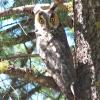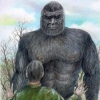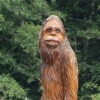Leaderboard
Popular Content
Showing content with the highest reputation on 01/13/2017 in all areas
-
Not claiming anything. But it's been said many times... You have to have people to have sightings. Really I can't see how they could survive the years with record breaking snowfall like this winter is turning out to have. Where's the food? What would they eat? Everything is buried under many feet of snow or has moved to lower elevations. Unless we could connect specific weather conditions with sighting reports, which wouldn't be easy because conditions can change on the edges of snowfall week to week or even day to day in some areas, we really would have a hard time interpreting what is going on.2 points
-
It could be kids too. I grew up on 54th an lake park. Played on the midway and would go ice skating there in the winter. I know that whole area well. There is no place for this creature there. But there is for kids.1 point
-
Bigfoots do not all do the same thing. It's not like there is just one bigfoot and many clones. In many cases, what one person is asserting is true, what another asserts to disprove it is also true, what is NOT true is the strength of the assumed connection between the two. In my region, the SW quarter of Oregon, about 200 miles E-W and 150 miles N-S, there are two separate patterns I've noticed so far. There's a fairly constant year around "background noise" level of reports and there is are local, brief, repeating seasonal spikes of activity. Normally I focus on those spikes because they occur in places, at times, where I'm interested in being, not just for bigfoot search / research. Those probably represent "migratory" groups or local groups shifting into a particular part of their locale for seasonal use. However, looking at the reverse, removing those spikes, something is real clear: there are bigfoots year around in some places that have particularly inhospitable weather which could migrate out to much more pleasant conditions somewhat easily but don't. Looking at BFRO reports, I see reports from Dec - Feb where the temperatures are in single digits F. A 40 - 60 mile walk, something easy enough to do just moseying along with the tail end of summer "vittles", would put them in locations that stay don't often freeze. Yet ... there are the reports, sightings, howls/screams, tracks, etc. Still, I think there should be more reports than there are. Most of the best (weather-wise) locations in winter have concentrations of human population. I think we're missing a piece of the puzzle, some food source, some kind of behavior, or maybe failing to recognize some topographical features that are right under our noses here, something that skews the picture away from what we expect it to be. I think there is an "ah-hah" moment lurking, that we have all the information, we just haven't seen the connection that brings it into focus. MIB1 point
-
Here's an article that explores all the various theories people propose for why sasquatches avoid trail cams. http://sasquatchresearchers.org/blogs/bigfootjunction/2014/11/17/bigfoot-trail-cam-avoidance-theories/1 point
-
Well, the structure reappeared again overnight. And by 'overnight' I mean I was walking by that spot at maybe 4:15 on my way out yesterday, and walked by around 8:45 this morning. Same tree, same construction, in fact it's even on the same side of the tree. Could it be a grounds crew gathering up the broken branches from storms to be mulched later? But they didn't gather all of them, and why leave them there for months at a time? I'm planning a little trip to the Camp Pine Woods area this weekend if the weather isn't tooo horrible, these are directly south of the Potawatomi Woods we checked out last time and found the large teepee structure. I said I'd give a little background on my Colorado semi-suburban experiences, so here goes. I'll start off by pointing you to a BFRO report that should definitely qualify for this thread: http://www.bfro.net/GDB/show_report.asp?id=12802 This canyon I've had encounters in is basically two valleys West of that sighting into the mountains. This will be copied and pasted from elsewhere I've written this up, forgive me if there's context missing in places. My folks live on the edge of the suburbs, just behind the first ridge of the mountains. There's a road just to the south that runs up a canyon and into the mountains, and if you take that just a little ways up to your first left, there's a trail that's not that well marked or hiked. It's the back side of a system of trails that are well marked and hiked, and it connects with that system at the top, but is hidden - if you went down it from the main system, you'd end up far from your vehicle. It's densely forested, doesn't get much sun, and is almost always snowy, muddy, or both. The first time I brought one of the friends from the Lost Creek expeditions on this trail we heard knocks - two sharp cracks when we stepped out of the car, and another two when we started hiking up the trail. I don't remember if we heard anything else that time, but it was enough to get me hiking this trail pretty regularly by myself, since I was living at my parents' house at the time. The closest encounter I've had occurred on my way down the trail after I'd been hearing little noises on the way up, making me suspect they were around. I suddenly heard a loud "WOO!" from down to my right. I was feeling good so I went "WOO!" back. In immediate response to this, from off to the right, came a loud squawking/screeching sound. I grinned and sat down to see what would happen. Pretty quickly, I began to hear what I thought at first was someone walking a dog up the trail toward me - a quiet panting, "huhuhuhuh..." But as it got louder, and louder, and louder, I could only imagine the chest cavity of whatever was making this sound to be utterly massive... "huhuhuHUHUHUHHUHHUHHUHHUH" rapid, loud, heavy breathing, and it was CLOSE, it sounded like it was within 20 or 30 yards of me, but I couldn't tell where. It definitely scared me, but I had my voice of reason present enough to think "Well ok, I'm pretty sure I know what this is and what it's trying to tell me, I should just take the hint." I stood up and started walking down the trail, and the huffing stopped immediately. I never saw what was making the sound. I tried to entertain the possibility that it was a bear or lion for a while, but it just doesn't seem possible anymore. It was bigger than a mountain lion, bigger than a black bear, not to mention neither of those animals seem like a prime candidate to try to scare me away by breathing heavily while remaining completely hidden. I suspect the initial vocals I heard were bold curious youngsters, and Dad got nervous and wanted me out of there. It's not the only time I've felt like I was being warned to back off there. Near the top of the trail, near a big tree that's been broken and bent to the ground (it's still alive though), I found a stick structure that's a staple in the Sasquatch repertoire: a teepee (1, 2, 3). I went back and got my camera and snapped those three pictures, but... I felt really uncomfortable while doing so. It's hard to explain the "vibe-y" things that go along with this hobby, but I felt like I was violating them somehow, doing something that they'd strongly disapprove of. I had no indication that they were watching me, it's just a feeling I had. Less than 24 hrs later, I hiked the trail again, and just inside the trees at the bottom, right on the middle of the trail, was a deer skeleton, fresh, skull with three vertebrae attached, broken femurs, scattered about. I can pretty much guarantee nobody had hiked there since me yesterday, and I had a big feeling that this skeleton was left for me specifically. I decided then and there never to bring a camera with me again. Which is a bit of a shame considering the next thing I found, but I want respect for them and their wishes to be my number one priority. Fortunately, you can see the arched aspen tree that served as the base for the structure that I found a week or two later in the second picture of the teepee structure. That arch that starts just to the left of the teepee was the base and mouth for a lean-to type structure, at a time in July when we were getting an absurd amount of rain for Colorado. There were sticks placed perpendicular to it, all along the arch, weighing it down so the opening was probably 3-4 ft. high in the middle. All across these sticks, perpendicular again (so parallel to the arch) were 6 in. x 12 in. strips of aspen bark, making a very impressive roof. Maybe one more thing worth telling on this trail, which was another possible brief sighting, but again distant and obscured so I can't be completely sure. I was coming up to the steep spot where I'd heard the breathing, and a crazy amount of loud knocking issued from up the cliff to my left, almost like a belated "GUYS, HUMAN, MY BAD!" I just stood there looking up the slope, and something caught my eye - it looked like a tree trunk broken off about 10 ft. up, but I didn't remember seeing such a tree there. I just kept staring at it intently, sort of jokingly wondering if it would suddenly move, when it did. It moved smoothly to its right behind a tree and out of view, almost like it finally got unnerved by my staring at it. As with my previous sighting, not a clear enough look to say for sure it wasn't a trick of light, but plenty of non-sighting evidence to support that they at least frequent the areas.1 point
-
Short summary of my conclusions: Yukon Territory, Alaska, British Columbia, Northern California, Montana, Washington, Oregon, Manitoba, and Wyoming show multiple effects contributing to the Bigfoot phenomenon in these states. Hoaxing is present to a much higher degree here than in the rest of North America. Misidentification of black bears is another major contributor in these states. These two tendencies may be due to geographically-biased cultural effects (i.e., a general belief that this region is the "Bigfoot territory"). The remainder of the reports may be due to an uncataloged species. Idaho, Alberta, Colorado, New Mexico, Texas, Utah, Ontario, Oklahoma, Arkansas, South Dakota, Saskatchewan, Missouri, and Arizona are very interesting. Hoaxing here is only present at the same rate as in the remainder of North America. Misidentification of black bears does not contribute significantly to Bigfoot sighting reports in these states. Nearly all non-hoaxed reports here are likely due to an uncataloged species. The remainder of North America shows only contributions from hoaxing at this level of analysis. No correlations evidencing a contribution from sightings of animals, cataloged or uncataloged, were found in the data. One recommendation that comes from this research is that we should actually be devoting most of our efforts, insofar as report collection and analysis of specific details in reports are concerned, on the second set of states, outside of the "core" region consisting of the first set of states. This is due to a lower rate of hoaxing and absence of black bear misidentification. I hope to go deeper into this analysis in the coming weeks.1 point
-
Attached is the promised paper detailing the updated statistical analysis I mentioned in my previous post in this thread. bigfootupdatedanalysispaper.pdf1 point
-
Any given isolated report may be a hoax, or subject to any number of sources of error. A basic rule of empirical science is that you never draw any firm conclusions based on a single experiment or observation. Scientists strive for repetition and replication of experimental or observational results. Large sighting databases are valuable to Bigfoot research because they provide data in necessary quantities for drawing conclusions. The unique weakness of Bigfoot sighting databases, and "paranormal" data in general, is that we don't know to what degree the body of data has been tainted by heading or systematic misperception. This is where mathematical methods come into play. The best mathematical analysis of a Bigfoot sighting database that I am aware of is the analysis published by Glickman in 1998. The basic thrust of the method is that any person, in any place, at any time, is capable of submitting a hoaxes report. For this reason, the rate of hoaxing should be proportional to the human population. Similarly, if a Bigfoot sighting report is prompted by an encounter with an actual animal, then the more densely packed the people are in a given area, the more likely one or more of those people would be to encounter an animal residing within that area. Consequently, the rate of sighting reports of an actual animal should be proportional to the human population density. Using these two principles, Glickman analyzed the distribution of reports at the state level. He used a hierarchical cluster analysis (a method used to determine the similarity of individual pieces of data within a dataset) to divide the report database into two groups. Group A covered Alaska, Washington, Oregon, Northern California, Idaho, and Montana. Group B covered everything else. He found that in Group A, the number of reports per state showed a correlation with both the population and population density. The conclusion is that reports in these states are a result of a combination of hoaxing and actual animal sightings. On the other hand, Group B showed only a correlation with population, the conclusion being that reports in the rest of the country are solely due to hoaxing. In 2005 and 2006 I extended Glickman's analysis to check for correlations between the number of Bigfoot reports per state and the black and brown bear population densities in those states. There was no correlation with black bears in either Group A or B, and actually a negative correlation with brown bears in Group A. My conclusion was that we could eliminate the only two animals that could reasonably be mistaken for Bigfoot, and speculate that Bigfoot sightings really are due to an uncataloged animal species. Moreover, I concluded based on the brown bear data that Bigfoot and grizzly bears are natural enemies. Recently I've been updating all of these analyses based on the BFRO database instead of the outdated Green data that both Glickman and I had previously used. The BFRO database also allowed me to use Canada in the analysis. I should be finished with the analysis and write up shortly.1 point
-
Next time I have BF contact I will explain to them that they implausible and a social construct. Wonder if knowing that will make the bigfoot disappear from my photograph? Earth calling skeptics, people here have seen them!1 point
This leaderboard is set to New York/GMT-05:00







